1994 OLDSMOBILE SILHOUETTE brakes
[x] Cancel search: brakesPage 12 of 276
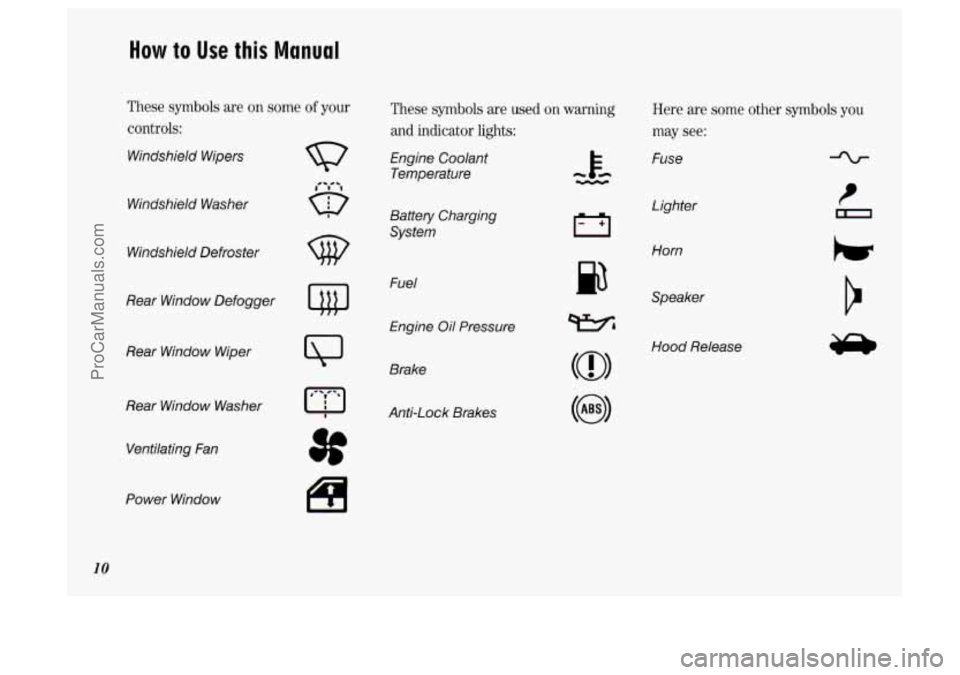
How to Use this Manual
These symbols are on some of your
controls:
Windshield Wipers
Windshield Washer
w
Windshield Defroster
Rear Window Defogger
Rear Window Wiper
Rear Window Washer Ventilating Fan
Power Window
10
3f
These symbols are used on warning
and indicator lights:
Engine Coolant Temperature
Battery Charging
System
Fuel
Engine
Oil Pressure
Brake
AntXock Brakes
p3
Here are some other symbols you
may see:
Fuse
Lighter
Horn
Speaker
Hood Release
ProCarManuals.com
Page 66 of 276

Features & Controls
64
R NoD2l
Forward Gears
(Automatic Overdrive):
If your automatic transaxle has
automatic overdrive, this position is for
normal driving. If you need more power
for passing, and you’re:
Going less than about 35 mph (56
km/h), push your accelerator pedal
about halfway down.
Going about 35 mph (56 Itm/h) or
more, push the accelerator all the way
down.
You’ll shift down
to the next gear and
have more power.
NOTICE:
This NOTICE applies only if you
have the
3800 V6 engine and the
automatic Overdrive transaxle. If
your vehicle
is so equipped, and if it
seems to start up rather slowly, or if
it seems not to shift gears as you go
faster, something may
be wrong
with a transaxle system sensor. If
you drive very far that way, your
vehicle can be damaged.
So, if this
happens, have your vehicle serviced
right away. Until then, you can use
2 (Second Gear) when you are
drivin less than
35 mph (56 ltm/h)
and
d D (Overdrive) for higher
speeds.
D (Third Gear): If your automatic
transaxle does not have Overdrive, this
position is for normal driving, at all
speeds, in most street and highway
situations.
If your automatic transaxle has
Overdrive,
D is like m, but you never
go into Overdrive. Here are some times
you might choose
D instead of m:
When driving on hilly, winding roads.
When towing a trailer, so there is less
When going down a steep hill.
2 (Second Gear): This position gives
you more power but lower fuel
economy. You can use
2 on hills. It can
help control your speed as you go down
steep mountain roads, but then you
would also want to use your brakes
off
and on.
shifting between gears.
NOTICE:
Don’t drive in 2 (Second Gear) for
more than
5 miles (8 ltm), or at
speeds over
55 mph (88 ltm/h), or
you can damage your transaxle.
Use
D (m or D if your vehicle has
Overdrive) as much as possible.
Don’t shift into
2 unless you are
going slower than
65 mph (105
ltm/h), or you can damage your
engine.
1 (First Gear): This position gives you
even more power (but lower fuel
economy) than
2. You can use it on
very steep hills, or in deep snow or
ProCarManuals.com
Page 67 of 276
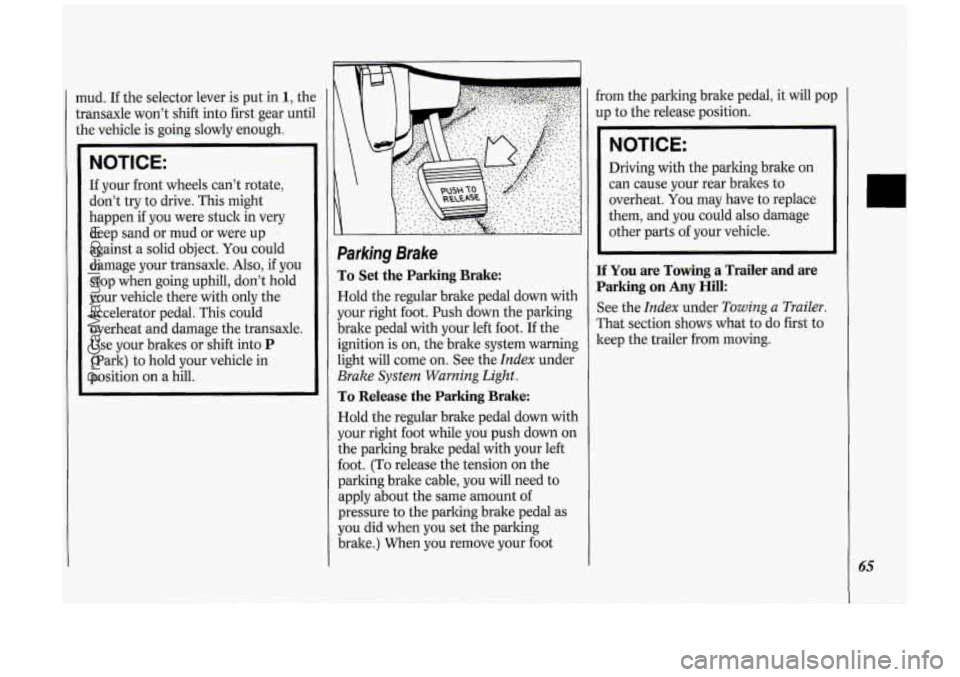
ud. If the selector lever is put in 1, thc
ansaxle won’t shift into first gear unti
le vehicle is going slowly enough.
NOTICE:
If your front wheels can’t rotate,
don’t try to drive.
This might
happen
if you were stuck in very
deep sand or mud or were up
against a solid object.
You could
damage your transaxle. Also,
if you
stop when going uphill, don’t hold
your vehicle there with only the
accelerator pedal. This could
overheat and damage the transaxle.
Use your brakes or shift into
P
(Park) to hold your vehicle in
position on a hill.
Parking Brake
To Set the Parking Brake:
Hold the regular brake pedal down with
your right foot. Push down the parking
brake pedal with your left foot. If the
ignition is on, the brake system warning
light will come
on. See the Index under
Brake System Warning Light.
To Release the Parking Brake:
Hold the regular brake pedal down with
your right foot while you push down on
the parking brake pedal with your left
foot. (To release the tension on the
parking brake cable, you will need to
apply about the same amount of
pressure to the parking brake pedal as
you did when you set the parking
brake.) When you remove your foot from
the parking brake pedal, it will pop
up to the release position.
NOTICE:
Driving with the parking brake on
can cause your rear brakes to
overheat.
You may have to replace
them, and you could also damage
other parts of your vehicle.
If You are Towing a Trailer and are
Parking on
Any Hill:
See the Index under Towing a Trailer.
That section shows what to do first to
keep the trailer from moving.
ProCarManuals.com
Page 74 of 276
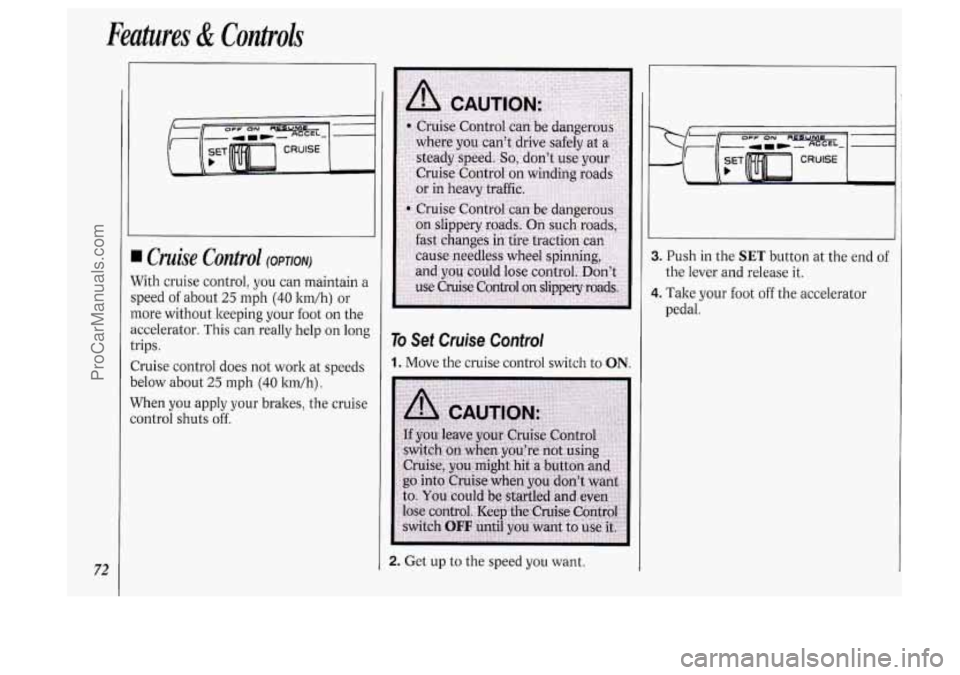
Features & Controls
72
I Cruise Control (OPTION)
With cruise control, you can maintain a
speed of about
25 mph (40 lun/h) or
more without keeping your foot on the
accelerator.
This can really help on long
trips.
Cruise control does not work at speeds
below about
25 rnph (40 ltm/h).
When you apply your brakes, the cruise
control shuts
off.
To Sef Cruise Control
1. Move the cruise control switch to ON.
2. Get up to the speed you want.
3. Push in the SET button at the end of
4. Take your foot off the accelerator
the
lever and release it.
pedal.
ProCarManuals.com
Page 106 of 276
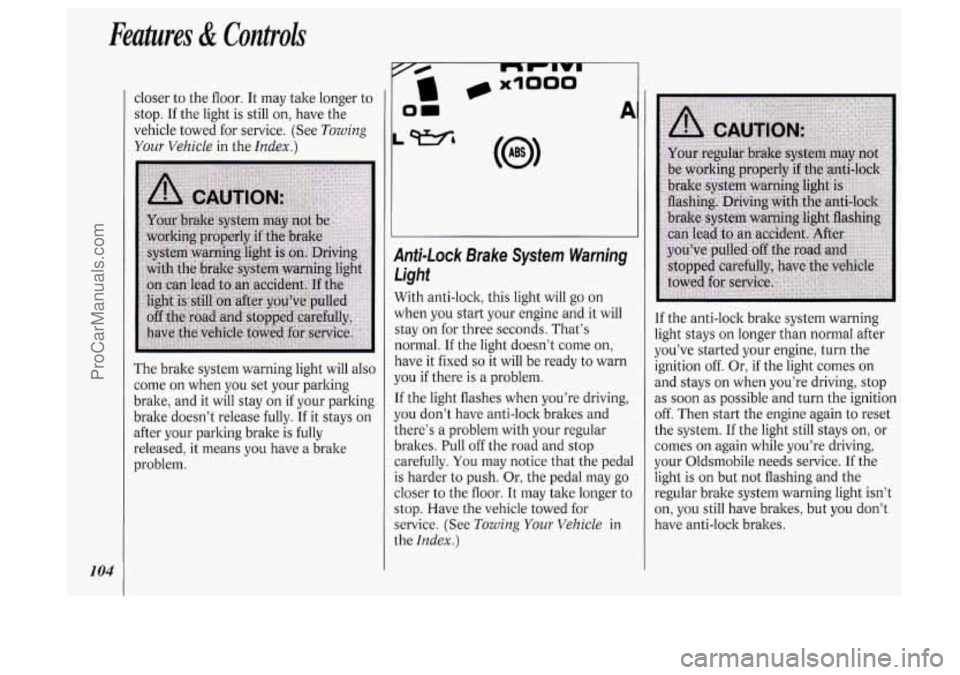
Features & Controls
104
closer to the floor. It may take longer to
stop. If the light is still on, have the
vehicle towed for service. (See
Towing
Your Vehicle in the Index.)
The brake system warning light will also
come on when
you set your parking
brake, and it will stay on if your parking
brake doesn’t release fully. If it stays on
after your parking brake is fully
released, it means you have
a brake
problem.
L Wb
Anti-Lock Brake System Warning
Light
With anti-lock, this light will go on
when you start your engine and it will
stay on for three seconds. That’s
normal. If the light doesn’t come on,
have it fixed
so it will be ready to warn
you if there is a problem.
If the light flashes when you’re driving,
you don’t have anti-lock brakes and
there’s a problem with your regular
brakes. Pull off the road and stop
carefully.
You may notice that the pedal
is harder to push. Or, the pedal may go
closer to the floor. It may take longer to
stop. Have the vehicle towed for
service. (See
Towing Your Vehicle in
the
Index.)
I
If the anti-lock brake system warning
light stays on longer than normal after
you’ve started your engine, turn the
ignition off. Or, if the light comes on
i
and stays on when you’re driving, stop !
as soon as possible and turn the ignition
off. Then start the engine again to reset
! I
the system. If the light still stays on, or j
comes on again while you’re driving, ~
your Oldsmobile needs service. If the !
light is on but not flashing and the
regular brake system warning light isn’t
on,
you still have brakes, but you don’t
have anti-lock brakes.
ProCarManuals.com
Page 107 of 276
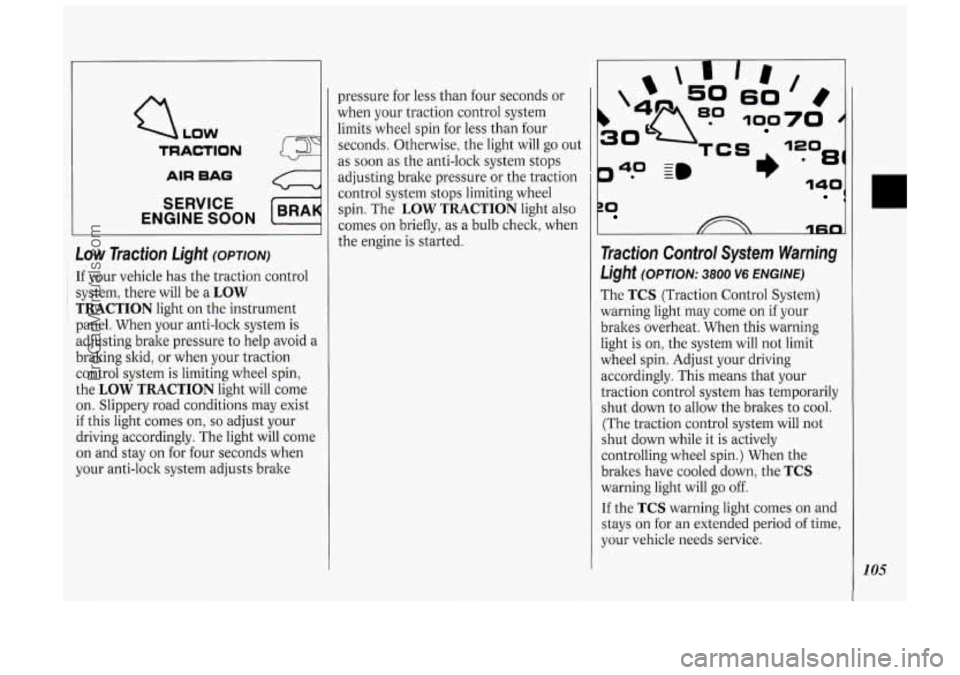
(J LOW
TRACTION -'I
AIR BAG
SERVICE
ENGINE
SOON
Low Traction Light (OPTION)
: If your vehicle has the traction control
~ i system, there will be a LOW
TRACTION light on the instrument
panel. When your anti-lock system is
adjusting brake pressure to help avoid a
braking skid, or when your traction
control system is limiting wheel spin,
the
LOW TRACTION light will come
on. Slippery road conditions may exist
if this light comes on, so adjust your
driving accordingly. The light will come
on and stay on for four seconds when
your anti-lock system adjusts brake pressure
for less than four seconds or
when your traction control system
limits wheel spin for less than four
seconds. Otherwise, the light will go out
as soon as the anti-lock system stops
adjusting brake pressure or the traction
control system stops limiting wheel
spin. The
LOW TRACTION light also
comes on briefly,
as a bulb check, when
the engine is started.
P* -
40 ~m
rn
60
100
81)
ZO 1
1fin
Traction Control System Warning
Light (OPTION: 3800 V6 ENGINE)
The TCS (Traction Control System)
warning light may come on if your
brakes overheat. When this warning
light is on, the system will not limit
wheel spin. Adjust your driving
accordingly. This means that your
traction control system has temporarily
shut down to allow the brakes to cool.
(The traction control system will not
shut down while it is actively
controlling wheel spin.) When the
brakes have cooled down, the
TCS
warning light will go off.
If the TCS warning light comes on and
stays on for an extended period of time,
your vehicle needs service.
105
ProCarManuals.com
Page 133 of 276
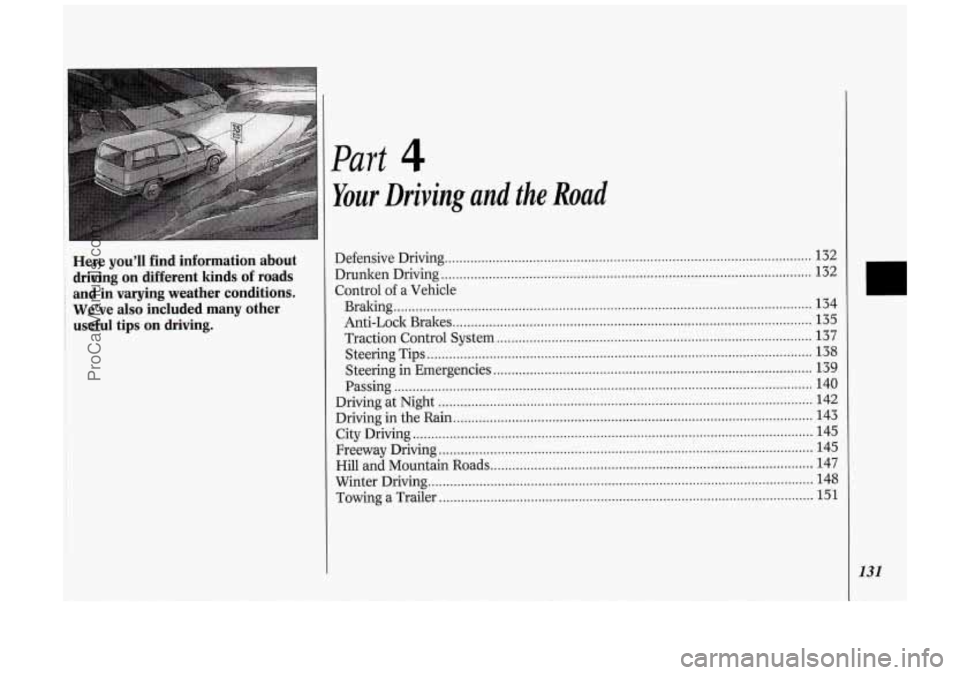
Here you’ll find infoimation about
driving on different kinds
of roads
and in varying weather conditions
.
We’ve also included many other
useful tips on driving
.
Part 4
Your Driving and the Road
Defensive DrlWg 132
Dmnken Driving
........................................................................\
............................. 132
Control
of a Vehicle
Braking
........................................................................\
.......................................... 134
Anti-Locls: Brakes
........................................................................\
.......................... 135
Traction Control System
........................................................................\
.............. 137
Steering Tips
........................................................................\
................................. 138
Steering in Emergencies ........................................................................\
............... 139
Passing
........................................................................\
.......................................... 140
Driving at Night
........................................................................\
.............................. 142
Driving in the Rain ........................................................................\
.......................... 143
City Driving
........................................................................\
..................................... 145
Freeway Driving
........................................................................\
.............................. 145
Hill and Mountain Roads
........................................................................\
................ 147
Winter Driving
........................................................................\
................................. 148
Towing a Trailer
........................................................................\
.............................. 151
.. ........................................................................\
............................
..
131
ProCarManuals.com
Page 136 of 276
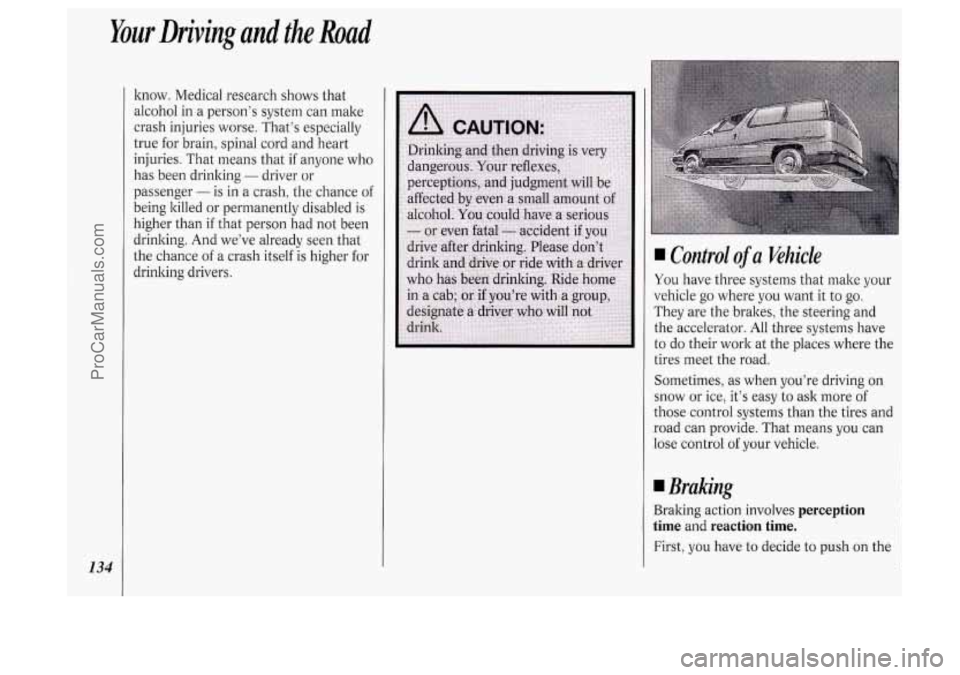
Your Driving and the Road
134
know. Medical research shows that
alcohol in
a person’s system can make
crash injuries worse. That’s especially
true for brain, spinal cord and heart
injuries. That means that if anyone who
has been drinking
- driver or
passenger
- is in a crash, the chance of
being killed or permanently disabled is
higher than if that person had not been
drinking. And we’ve already seen that
the chance
of a crash itself is higher for
drinking drivers. I Control of a Vehicle
~~
You have three systems that make your
vehicle go where
you want it to go.
They are the brakes, the steering and
the accelerator.
All three systems have
to do their work at the places where the
tires meet the road.
Sometimes, as when you’re driving on
snow or ice, it’s easy to ask more of
those control systems than the tires and
road can provide. That means
you can
lose control
of your vehicle.
I Braking
Braking action involves perception
time
and reaction time.
First, you have to decide to push on the
ProCarManuals.com